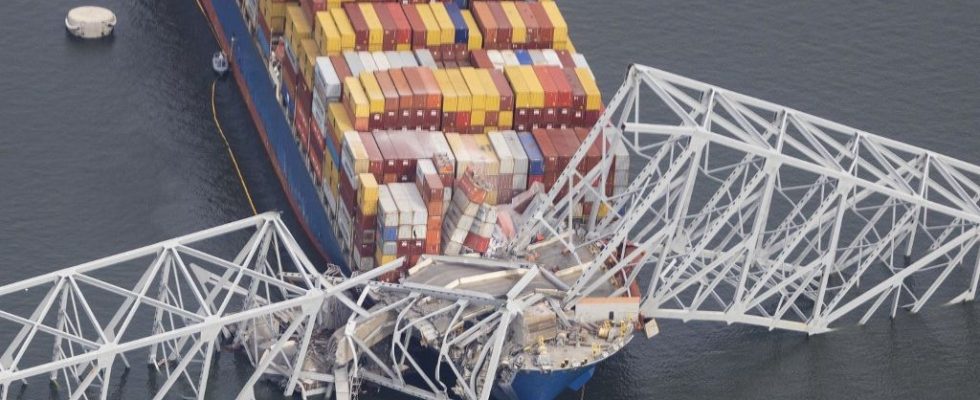A particularly spectacular chain collapse. The disaster that occurred Tuesday morning in Baltimore (United States), after a container ship, the Dali, hit a pile of the Francis-Scott-Key bridge, led to the fall of the metal structure into the Patapsco River in just a few seconds.
“The fact that the bridge collapsed suddenly and completely is absolutely not surprising, however, assures 20 minutes Arthur Lebée, chief engineer of water and forest bridges, researcher at the Navier laboratory, and lecturer at the ParisTech bridge school. From the moment you cut the foot of the bridge, everything falls, which is all the more true considering the mass of this ship and the weight of this bridge. You honestly don’t need to be a great engineer to understand that the structure was going to collapse under the impact. »
Jacques Combault, honorary professor at the National School of Bridges and Roads, draws up exactly the same analysis. “The collapse of the bridge occurred in an order that I could have imagined in advance… It is the pier that must resist, not the deck. »
“More a subject of ship traffic control”
The two specialists are even more surprised to see such a ship circulating in this place. Built in 2015 in South Korea by the shipbuilding company Hyundai, owned by Grace Ocean, the Dali was chartered on Tuesday by Maersk (world number 2 in containers) and was bound for Colombo, Sri Lanka. 300 meters long, 48 meters wide, 24.8 meters high and 15 meters draft, its carrying capacity is of the order of 116,000 tonnes.
A real monster in front of the Francis-Scott-Key metal bridge, built between 1972 and 1977, and which linked the city of Baltimore, in the state of Maryland, to the community of Dundalk along its 2.6 km.
“This bridge was built in 1972, the specifications for the design of this work were therefore not those of today’s traffic,” analyzes Arthur Lebée. And this is not the responsibility of the designer of the structure, it is the responsibility of the people who manage the traffic around this structure. We are therefore more concerned with the control of vessel traffic than with engineering. »
“The question would be to know from when we agreed to let container ships of this size and this mass pass under this structure,” Jacques Combault also wonders. Because it is certain that the bridge was not designed to withstand impacts with such large boats, or even smaller boats for that matter. »
“The battery design is questionable”
This does not prevent the two specialists from questioning certain aspects of the work. “The design of the pier is questionable: the fact that there are two small posts, relatively narrow, compared to the massiveness of the bridge, means that with the impact of such a ship the rupture would take place,” continues Arthur Lebée. And around the pier, usually, you have an island that overprotects it, here it was quite small, so the ship touched the pier with its nose before it even hit the ground. » “The pile does not seem very massive, and did not seem to be able to withstand a container ship of this size,” adds Jacques Combault. Even a lighter boat could have managed it. »
Arthur Lebée adds that the structure of the bridge, in latticework, may be complex, “it is renowned for being not very robust, in the sense that there is little redundancy: if one thing breaks, the whole thing breaks.”
“We avoid installing piers in the navigable pass”
Jacques Combault finally points out another element. “Generally speaking, when we design large bridges over a river, or near river mouths, we avoid installing piers in the navigable channel. This is the reason why the three great bridges of France, the Brotonne bridge, the Tancarville bridge and the Normandy bridge, are built with piers located outside the waterways. This generally requires larger spans, which represents a cost, but avoids this problem of collisions with boats, which remains so uncertain. »
Random, and not that rare. “The destruction of structures by ship strikes is quite regular, there may be two or three in a year, but generally we do not talk about it, because they are not large structures, and there is no there are no victims,” assures Jacques Combault.
The engineer recalls, however, that on May 9, 1980, a similar accident ended in a real catastrophe. The Sunshine Skyway Bridge in Florida was partially destroyed following a collision with the cargo ship Summit Venture after a storm. The tragedy left 35 dead. The structure has since been completely rebuilt.
Already an accident with the MV Dali
This time, the MV Dali would have had time to launch an SOS to inform the authorities of a loss of power problem, which helped reduce traffic on the bridge before the impact.
The same ship had already been the cause of an accident: on July 11, 2016, it collided with the berth of the container terminal of the port of Antwerp, in Belgium, causing significant damage to the vessel. the stern and the transom. There were no casualties.

